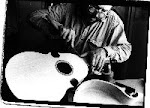My name is Andrea and I live in Italy. I bought your marvellous book many years ago, but only recently I decided it was time for me to build (try at least) my first guitar. After reading again your book I have a doubt: the soundboard is domed but, as far as I can see, there is no mention about shaping the bridge accordingly. Is it because the doming is so little in the central area that a flat bridge is correct ?
===================================================
While my building technique relies on a domed soundboard, it does not call for a bridge with a curved base.
Soundboard doming schemes vary widely among builders. It depends on what each individual luthier has learned from their teacher or how they individually perceive what the consequences or importance of doming to be. Clearly there is no rule or law in this regard.
In your country, luthiers of high reputation construct their tops differently. For example, Mario Garrone of Piemonte and Mario Rosazza of Roma build their tops completely flat with no doming at all, while Gabriele Lodi of Modena, in fact, does dome his soundboards.
Among builders who build their tops completely flat, obviously their bridges are flat also. But among those who dome their tops, some of them attempt to match the curve of the base of their bridges to match the curve of the soundboard at the bridge location. But some, like myself dome the tops, but choose to leave our bridges flat.
I can't tell you what justification the others have for these choices, you would have to ask them.
But as for me, I dome my top because I am certain that in itself this adds rigidity to the top plate, and allows me consequently reduce the thicknesses of the top plate and heights of the braces. I believe in minimal adequate structure, as you will quickly learn if you read my other posts on this blog.
Conversely, I would expect that if I was building completely flat, I would feel constrained to increase the thicknesses of the plates and heights of the braces to compensate for the top's relative weakness in a flat state.
I don't see much point in going to the trouble of hollowing the base of the bridge (and don't forget now, your bridge block must also be made correspondingly curved by the same amount in the opposite manner if you wish to preserve the bridge's contour when you are gluing it to the top).
All this is seems unnecessarily troublesome to me, particularly since you would have to be able to ascertain with precision the extremely slight curvature that is developed along the few centimeters of the bridge's length. Unnecessary, because in any case, it is my conviction that since all the elements of the soundboard are essentially elastic to some degree or other, the effect of the string's tension upon the bridge is too drag it into a new contour regardless of whether it is flat or curved.
I believe that string tension is enough to distort whatever laboriously-determined curvature was imparted in the first place. Indeed, I have seen how the string's torquing forces over time inevitably cause the bridge to slightly dip in the front and slightly bulge in the back on a good, lightly-built guitar. I would not be surprised that the tiny bit of curve imparted to the bridge would be long-lost by that time.
But that is my reasoning and thus my choice. All the others are welcome to their own traditions, rationale and experience. Great guitars are possible whichever scheme you choose.

